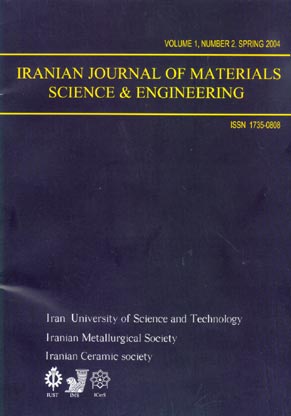فهرست مطالب

Iranian Journal of Materials science and Engineering
Volume:1 Issue: 2, Jun 2004
- 69 صفحه،
- تاریخ انتشار: 1383/02/11
- تعداد عناوین: 7
-
-
MATHEMATICAL MODELLING OF THE EFFECT OF FOAM DEGRADATION ON MOULD FILLING IN THE GREY IRON EPC PROCESSPage 1In this investigation a new model was developed to calculate gas pressure at the melt/foam interface (Gap) resulting from foam degradation during mould filling in the Lost Foam Casting (LFC) process. Different aspects of the process, such as foam degradation, gas elimination, transient mass, heat transfer, and permeability of the refractory coating were incorporated into this model. A Computational Fluid Dynamic (CFD) code was developed based on the numerical technique of the SOLution Algorithm- Volume Of Fluid (SOLA- VOF) utilizing model, for the simulation and prediction of the fluid flow in the LFC process. In order to verify the computational results of the simulation, a thin plate of gray iron was poured into a transparentfoam mould. The mould filling process was recorded using a 16mm high-speed camera. Images were analysed frame by frame, in order to measuring foam depolymerization rate and the gap volume during mould filling. Comparison between the experimental method and the simulation results, for the LFC filling sequence, has shown a good agreement.
-
PREPARATION OF CATALYTIC COATING OF TITANIUM OXIDE BY MEANS OF ELECTROLYTIC DEPOSITIONPage 2In the current research, the optimum conditions for the electrolytic deposition of TiO2 coatings on titanium pieces were experimentally investigated. Flat pieces of commercially available titanium with dimensions of 50 x20 x3 mm were used as the anode and cathode electrodes. The coatings were applied on the cathode in an electrolyte solution essentially from water and methanol, containing different amounts of TiCI4, and H202. Coatings of sufficient thickness and adequate adhesion to the substrate were obtained at the optimum conditions of theELD process. The latter conditions were electrode gap distance of 3 cm, TiCl4 concentration of 0.005M, H202 concentration of 0.1 M, current density of 35 mA/cm2, methanol/water volume ratio of 9, and pH of the electrolyte in the vicinity of 1.40. Results of XRD analysis revealed the presence of anatase crystals of titanium oxide in the coated layers, where the deposited coating was treated at some temperatures in the range of 400 to 600°C for a period of at least 2 hours. Scanning electron microscopy (SEM) pictures also confirmed the formation of a uniform coating layer with cracked suiface area. At the optimum conditions of the process coatings with thicknesses of up to 10 flm were easily obtained through the application of one to three deposited layers.
-
IN-SITU FABRICATION PROCESS OF AL- TIC COMPOSITE BY SLAGPage 3The new in situ method for AI-TiC composite fabrication has been carried out. In this method, fabrication of AI-TiC composite by simultaneous introduction of titanium oxide and carbon into aluminum melt was investigated.. Under the process conditions, titanium and carbon reaction results in titanium carbide whiskers. The salt containing keriolite (Na3AIF6), titanium oxide (TiO2) and graphite used for this purpose. Using Scanning Electron Microscopy (SEM) and X-Ray Diffraction analysis (XRD) the resulted composite was characterized. It was shown that it contains Al as matrix and TiC as the reinforcement. Then, mechanical properties of fabricated composite were examined.
-
Flow Behavior of Molten Metal in Aluminum LFC ProcessPage 4The effects of gating system and pattern geometry on the metal flow in the lost foam casting (LFC) process have been investigated using glass covered mold and video recording system. Unlike convectional casting process, the type of the gating system showed little effect on fillability in lost foam, but pattern thickness had large effect on mold filling. The mold filling behavior seems to be controlled by the combined influences of heat and mass transfer. The flow rate increased with increasing pattern thickness.
-
CALCIUM PHOSPHATE CEMENT: STUDY OF (BETA-TRICALCIUM PHOSPHATE, DICALCIUM PHOSPHATE AND CALCIUM CARBONATE SYSTEMPage 5Calcium phosphate cements (CPCs), using B-tricalcium phosphate (ß-TCP, Ca3 (P04)2), dicalcium phosphate (DCP, CaHP04), calcium carbonate (Ca CO3), and hydroxylapatite (HAp, Ca10(P04)6(OH)2) as powder cement and disodium hydrogen phosphate (Na2HP04) solution as liquid component were prepared. After mixing the powder and liquid constituents, injectable and self-setting calcium phosphate cements (CPCs) were prepared with different liquid to powder ratios (UP) that formed hydroxylapatite and ß-tricalcium phosphate as the only end products, which were characterized by FTIR, XRD and SEM techniques. The results showed that, at certain concentration of Na2HP04 (6 wt%), the initial and final setting times decreased by decreasing the UP ratio.
-
EFFECTS OF REINFORCEMENT VOLUME FRACTION, REINFORCEMENT SIZE AND SOLUTION HEAT TREATMENT ON THE MICROSTRUCTURE OF THE TWO DIFFERENTLY PROCESSED A35&SICPCOMOSITESPage 6
-
COMPUTER SIMULATION OF FLUID FLOW FILLING DURING MOLD USING FINITE VOLUME METHODPage 7In this investigation, α 2-D Finite Volume Method (FVM) with unstructured triangular mesh is developed to simulate the mould filling process. The simulation of fluid flow and track of free surface is based on the Marker And Cell (MAC) technique. This technique has capability ofhandling the arbitrary curved solid boundaries in the casting processes. In order to verify the computational results of the simulation, a thin disk plate with transparent mould was tested. The mould filling process was recorded using a 16mm high-speed camera. Images were analyzed frame by frame, in order to tracking of free surface and filling rate during mould filling. Comparison between the experimental method and the simulation results has shown a good agreement.

